| 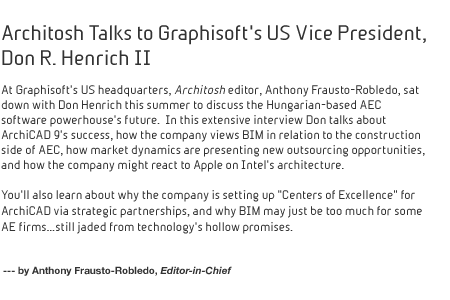
This
past summer I had the pleasure of spending a good deal
of time talking to Graphisoft North America's Vice President
and General Manager, Don Henrich II, at the company's Boston-area
headquarters. The company, as you may know, is famously based
out of Hungary, a country known for its mathematicians,
the Rubik's Cube, and of course -- at least in the CAD world
-- for ArchiCAD.
What
was of particular interest to me in talking to Mr.
Henrich, was the discussion of how the company views
"building
information modeling" (BIM) as opposed to CAD (computer-aided
design
or drafting), since nearly twenty years ago the first versions
of ArchiCAD, as crude as they now seem, were elegantly correct
in estimating that the ultimate purpose of computers in architecture
would be to facilitate the creation of "virtual buildings".
Building Information Modeling, as it is called, is actually
a somewhat radical departure from the norms of draftsmanship
in architecture and engineering, in that instead of drawing
2D representations of the building as a whole, the building
is actually constructed in 3D ("modeled") and then "viewed"
in order to produce 2D drawings.
This
more scientific way of thinking about built information
assumes that what a computer ought to do is to essentially
take special x-rays of the "virtual building" in
3D computer space. These x-rays are then passed off and noted
and ultimately
form the basis for conventional drawings. Yet, what makes
this system fundamentally more scientific is that the virtual
building, like the human body in an x-ray, is freighted with
useful data. The ArchiCAD program is able to both load and
extract that useful data, and thus manage it in a multitude
of ways useful to the AEC professional.
We
start off this interview by talking about ArchiCAD
9 and what makes it the preferred BIM software application
in the market.
[AF-R]
Don, if you don't mind I'd like to start off by
asking you to talk about the latest
version of ArchiCAD and how this company views that product
as the preferred BIM product
in the market?
[Don
R. Henrich II] Version
9 has been a very successful release for the company,
and there are probably two factors relating to that.
One factor is that version 8 was not so successful, so
people were waiting with sort of baited breath for version
9. And I think we did a really high quality job with
ArchiCAD 9 and delivered it on schedule.
It
has also been a monetary success for us, as a larger
legacy group of customers have adopted it quickly. And
that has become a customer service success for us as
well because it is easier for us to serve them well.
[AF-R]
And the second factor?
[Don]
The second thing is that there have always been these
very
large companies with a toe-in-the-water [of BIM] and
now they are trying to put a foot in the water -- this
is
in respect
to what you want to talk about with BIM -- and we are
considered one of maybe two or three products that you
must review if you are seriously interested in BIM.
So
it's been a very successful release in terms of new customer
adoption, especially firms in the 5-20 man range.
Those are very successful for two reasons, one is that
the decision making process is very straight forward.
When a shop like that wants to change they can literally
do it within a couple of weeks -- they can commit, get
the training and literally move forward on the change-over
on the next project.
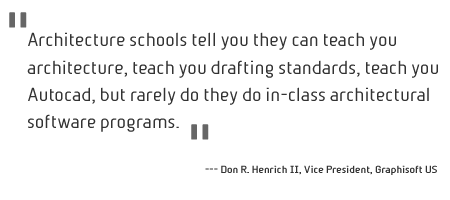
[AFR] Is that because the projects are generally smaller
and handled by a couple of people on the project?
[Don]
No, that could be part of it...no, in fact, we have
a firm that is about 33 people and they do giant projects
and they were quick to change. It's not necessarily about size
but about who is in the firm and if there are generational
issues at play.
[AFR]
Are you speaking about the older generation who had to adopt
CAD mid-career in practice?
[Don]
Yes. We look at the educational market, and we think
that
that
is where part of the problem is, because literally some
of the older professors probably started on ink on mylar,
then struggled with 2D CAD and now literally don't want
to embrace 3D CAD. I am sure that some of them do, but
as a large body there is resistance too, so what they
do often is, they say: "hey, you are here to do
architecture, we'll teach you architecture, and we'll
let you use whatever
computer software products you want to use".
Architecture
schools tell you they can teach you architecture, teach
you drafting standards, teach you Autocad, but rarely
do they do in-class architectural software programs.
[AFR]
So the educational sector is clearly a place where this
company can develop a strategy going forward to both
"educate" the profession as well as gain more users essentially?
[Don]
Yes, the educational market is really important
to us. And it's a struggle that it is that important
because
there is very little money there. So when you look
at applying finite reasons it's really hard. So
we are looking right now to improve our
existing educational sales strategy.
We
have good ideas and I'd be happy to share those with
you when they are a bit more refined.
[AFR]
Sure.
[Don]
One of the challenges we face is how to enlist universities
in teaching Building Information Modeling (BIM) What
should we do and how do we influence
the educators?
[AFR]
How do you convince both educators and practicing professionals
of the value in BIM over 2D CAD drafting?
[Don]
We have a methodology called "benchmarking" --
it's kind of common practice in other industries.
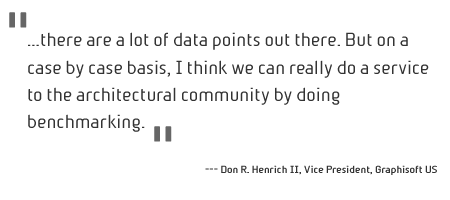
[AFR]
Are you talking about electronic benchmarking, like in performance
benchmarking?
[Don]
No. What we are doing is this. We are saying to practices that
do all 2D CAD today is: mark the line where you begin
to compete for business to the point at which you turn
over complete CDs (construction documents). So here is
your practice today.
Now,
there are firms that spend tons of money on things like
rendering studios, model makers -- and here are all the
things they do in their process and how long it takes
and how much it cost. Now ArchiCAD can do it in this
much time. (Don, holding hands in closer)
We
have customers tell us they have tripled their revenue
over the last five years, but they haven't hired any
new staff. So that says they are getting more and more
productive...or they are not sleeping.
[AFR]
Well sure, it does, it says they are being more productive.
[Don]
So, we know there are those data points out there.
But on a case by case basis, I think we can really do
a service to the architectural community by doing benchmarking.
If
you are really careful about the things you measure,
then you can get better at them. Then you can build process.
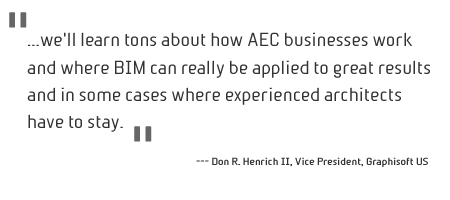
[AFR]
You are speaking, of course, about being less subjective
about how we think about CAD from a business decision
perspective.
[Don]
Yes. I often find at most of the trade shows and a lot
of the
online forums people are saying, "this is better than
that".
But they are being completely subjective.
[AFR]
But subjectivity is natural to this kind of thing. It's like
the age-old debate between Mac versus Windows. Rarely
do people look at both sides objectively or comprehensively.
[Don]
Sure. And it's okay to be subjective. There
is some amount of subjectivity in
every decision, but let's get some objectivity in it
as well. Why is that so hard?
When
you have a model maker, making you little models, that
adds a week to every story board that you want to
make,
and the model maker is a full-time employee with
benefits,
and
you don't consider that a cost when you are looking
at technology?
[AFR]
Sure it's a cost. Every part of the process pipeline
is a
cost. And it's clearly a savings if those little models
are replaced
in the process with some digital equivalent.
[Don]
That's right. So there are things like that you can [business]
model and have a lot
of fun with and we'll learn tons about how AEC businesses
work and where BIM can really be applied to great results
and in some places where experienced architects have to stay.
[AFR]
You are talking about business process re-engineering.
And in the architecture profession people generally aren't
that business savvy. They just aren't.
So
re-engineering their work flows, benchmarking,
this is all new information for a lot of them,
but I think it's good that you are talking about that
as a BIM provider.
[Don]
Yeah, and the people that we have spoken to at practices
in general have been very receptive. Some of the receptive
folks are CAD managers and some are principals.
[AFR]
In terms of benchmarking, do you see Graphisoft building
a tool or kit that will allow firms to benchmark themselves
for their own internal auditing?
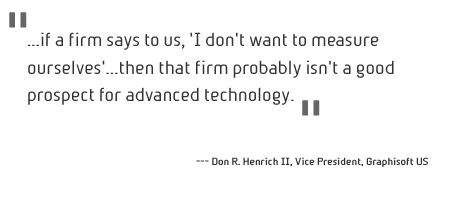
[Don]
Yes. We are working on documentation -- I call
it
the "process and the players." So you look
at early concept design, what tools do people use today?
And it's everything from hand sketches, free-form modeling,
et cetera. So you break up the architectural process
into its three
main phases where you can describe all the deliverables
and the tools that associate with them to support the
project.
Once
you do that, let's benchmark, let's do it with a building
we have already designed.
We
will look and see that it takes 30 people to support
a big project. And you can measure that. So I think the
benchmarking will help us to determine also which firms
to push, because if a firm says
to us, "I don't want to measure ourselves, I don't
want to know this stuff",
then that firm probably isn't a good prospect for advanced
technology.
[AFR]
They are most likely part of the 'laggards' group, they
adopted technology last the previous time, and they will
adopt
BIM last this time around as well.
[Don]
Yes, and apparently being very successful at doing it.
Yeah, I think you are right.
[AFR]
Let's talk about Revit for a moment. When people go shopping for a BIM and want
to transition from 2D Autocad to 3D BIM, do they automatically
go to Revit as their first choice, despite the fact that
you guys have been doing BIM for essentially two decades
now?
Continued >
page
| 1 | 2 | 3 | 4 |
[Edited:
4 Oct 2005, elimination of content.]
|






![]()
![]()